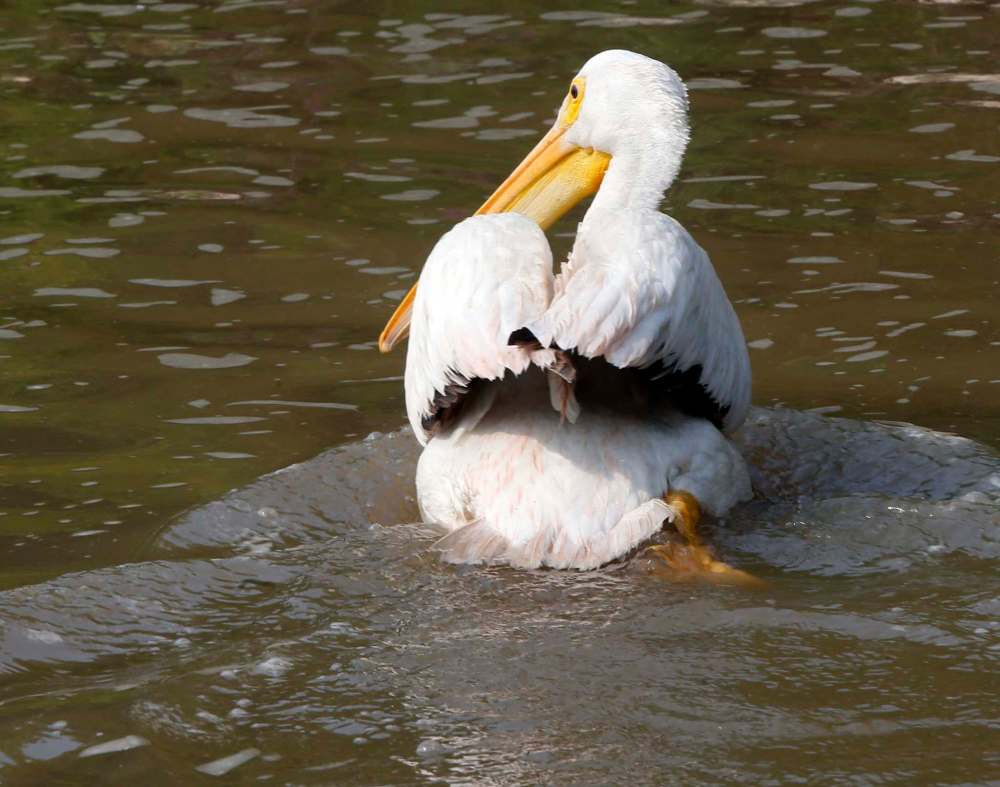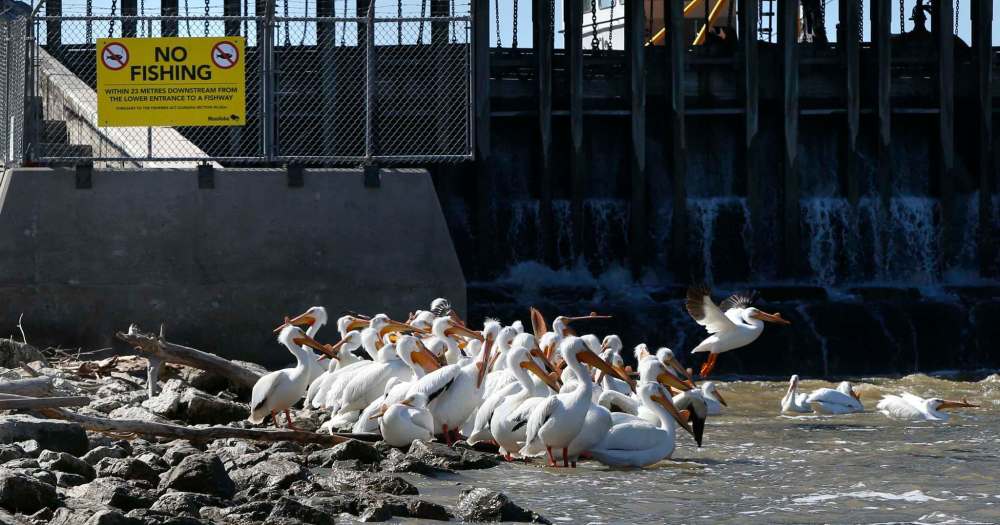Protecting pelicans
New conservation area at Lockport keeps birds safe, but shoreline litter still poses danger
Advertisement
Read this article for free:
or
Already have an account? Log in here »
To continue reading, please subscribe:
Monthly Digital Subscription
$0 for the first 4 weeks*
- Enjoy unlimited reading on winnipegfreepress.com
- Read the E-Edition, our digital replica newspaper
- Access News Break, our award-winning app
- Play interactive puzzles
*No charge for 4 weeks then price increases to the regular rate of $19.00 plus GST every four weeks. Offer available to new and qualified returning subscribers only. Cancel any time.
Monthly Digital Subscription
$4.75/week*
- Enjoy unlimited reading on winnipegfreepress.com
- Read the E-Edition, our digital replica newspaper
- Access News Break, our award-winning app
- Play interactive puzzles
*Billed as $19 plus GST every four weeks. Cancel any time.
To continue reading, please subscribe:
Add Free Press access to your Brandon Sun subscription for only an additional
$1 for the first 4 weeks*
*Your next subscription payment will increase by $1.00 and you will be charged $16.99 plus GST for four weeks. After four weeks, your payment will increase to $23.99 plus GST every four weeks.
Read unlimited articles for free today:
or
Already have an account? Log in here »
Hey there, time traveller!
This article was published 19/05/2016 (3455 days ago), so information in it may no longer be current.
LOCKPORT — White pelicans on the Red River near the Lockport dam are now safer on the water, but the nearby shoreline remains a potential death trap due to discarded fishing line and lures that can harm the birds.
Making good on last fall’s promise, the provincial government established the pelican special conservation area (SCA) as of Dec. 15, 2015. This area runs 75 metres along the eastern shoreline, which is off-limits to angling from April 1 to Nov. 15 annually.
The SCA was established following public outcry and a push by local fishers to protect the pelicans. The birds congregate by the hundreds in the choppy water at the foot of the dam to feed on the fish. Last year, numerous pelicans died after being caught in fishing line and starving or being mutilated by discarded fish hooks. Anglers were seen casting into crowds of pelicans and then cutting their lines if a hook got snagged on a bird. Local fishers rescued a few birds that had fish line around their beaks, feet and wings. They were too weak to fly or catch food.

The SCA and a separate area of 23 metres along the fish ladder that is off-limits to fishers are open to people to view the pelicans. The 2016 fishing season opened last weekend, resulting in garbage scattered along the shoreline, but not inside the SCA.
“It’s a great thing for pelicans to have a safe place near St. Andrews Lock and Dam for them to be but also a great opportunity for people to go to the site and see these beautiful birds,” said Nicole Firlotte, manager of biodiversity, habitat and endangered species for the Sustainable Development Department, which was involved in establishing the SCA. She noted the area is part of the Pine to Prairie Birding Trail, an international trail and tourism attraction that lures many birdwatchers.
“It’s always nice to have an area set aside for wildlife, and pelicans are just one of the many things that are important in our environment, but this is a very exciting opportunity for them.”
At a public consultation conducted last fall by the province, 69 per cent of the 265 respondents were in favour of the SCA, 26 per cent were not in favour and five per cent were undecided.
Surrounding the conservation area, there are three “No fishing or fishing equipment” signs, including one at the parking lot entrance to the walkway leading to the river. Another is posted on the north end of the chain-link fence in case someone decided to skirt the fence to enter the area.
Fishers on foot and in boats in the Lock and Dam area Tuesday morning kept their distance and cast into water away from the pelicans. Pelicans were floating, feeding and gathering on the shore in safety in the SCA.
Flyfisher Brian Woods said it’s too early to tell if the SCA will keep the birds safe.
“My initial thought was that I didn’t think that it (the SCA) was needed, someone obviously did. Years ago, I used to fish here often, and I never saw a pelican tied up. You might see the odd one, but you’re going to see that on any river or any lake,” he said, noting members of the Manitoba Fly Fishing Association respect birds and wildlife. “You don’t cast into them, that’s common sense. We flyfishers have a different mentality. There’s absolutely a lot of good places to fish, but there’s a lot of good fish that live in that fast water (at the foot of the dam).”

He said there is a shallow area near the middle of the dam, outside the conservation area, that lets fishers get to where those good fish can be caught, away from where the birds are floating.
Stu McKay of the retail business Cats on the Red said the angling industry in the area will remain strong because there’s plenty of fish in the river and many great places to fish.
“The difference will be there won’t be hordes of anglers in that area where the pelicans all feed. Long term, it’s going to be nothing but beneficial. Everybody will get used to it. There will be a few grumpy guys out there… whatever. They’ll get over it, too,” McKay said. “It’s just like the barbed hooks. I sat on that committee 30 years ago, and we pushed it through. There were guys crying in their beer at that time, ‘Oh, I’ll never fish Manitoba.’ Guess what? They still fish Manitoba.”
The shoreline outside the SCA is, however, another story.
Selkirk resident Cindy Kovach said the SCA is a step in the right direction but more needs to be done to ensure the pelicans’ safety because of the “idiots leaving garbage” on the shoreline.
Kovach and her sister have spent several days cleaning up the rocky shoreline near the lock and dam and have filled four large garbage bags of discarded fish line, twine, hooks, bags, food containers and fishing-equipment packaging. Tuesday morning, there were four new fish hooks, a pair of pliers, three beer cans, a potato chips cylinder, rubber gloves, three juice boxes and several metres of fish line among other garbage within 10 metres of the SCA fence.
“It’s ridiculous, how much we’ve picked up. People just don’t care, and it’s disgusting. That’s why every year we have birds that can’t migrate, whether they’re hooked in twine or they ate a fish with a hook in it,” said Kovach, who along with her sister saved three pelicans last year that had been injured by fish hooks or discarded fish line.
“ I know the officers make great contributions and are doing what they can; there just isn’t enough of them, and they can’t sit here all day. I just don’t understand why people can’t pick up after themselves. My heart goes out to these poor birds. There’s nowhere for them to go (on the shore). This is the first time (this season) that I’ve seen so many over there (in the SCA), so I hope they learn to go there.”

Kovach said provincial enforcement officers will have to make surprise visits to the area because she saw people fishing at night in the SCA and “bragging in Selkirk they were fishing in the fish ladder” because they think no one will catch them.
Anyone caught fishing in the SCA will be subject to a fine as high as $25,000 and a mandatory court appearance where a judge will determine the amount of the fine, a provincial spokesman said.
Firlotte said the “leave only footprints and take only memories” adage applies to everywhere in the environment.
Littering carries a fine of $190.
ashley.prest@freepress.mb.ca
History
Updated on Thursday, May 19, 2016 7:00 AM CDT: Adds photos

